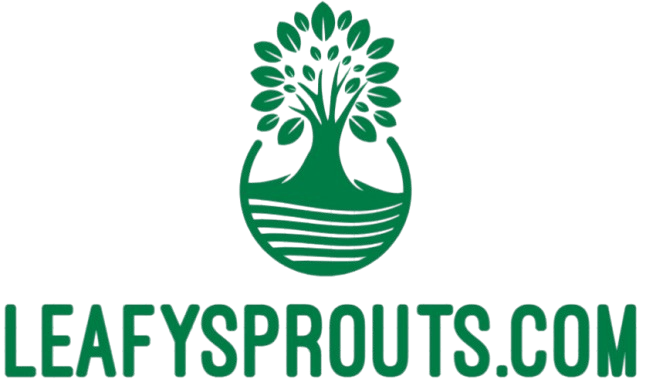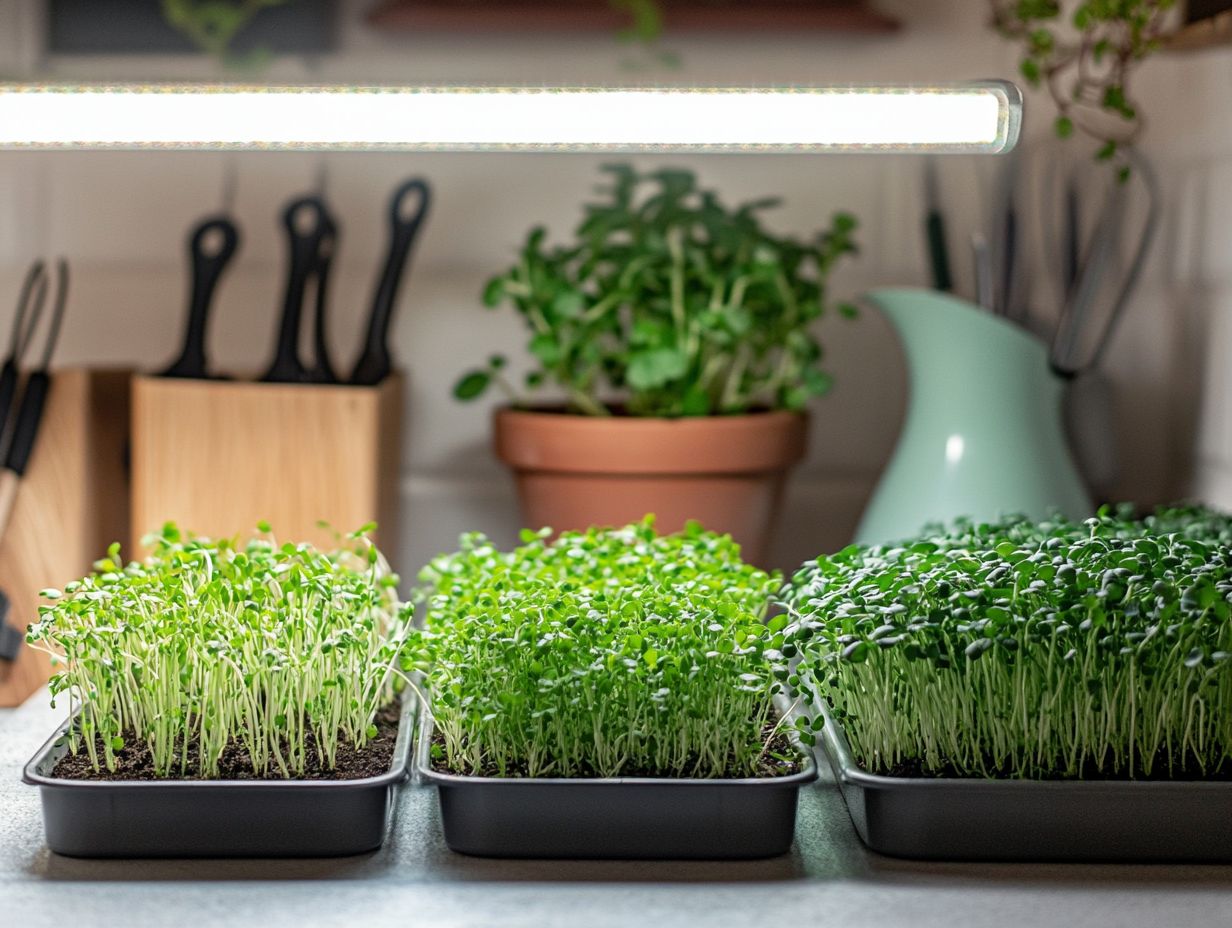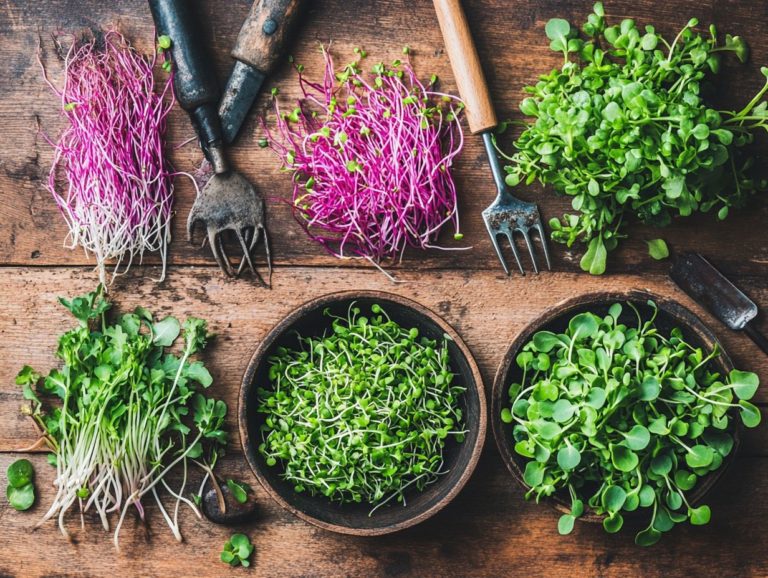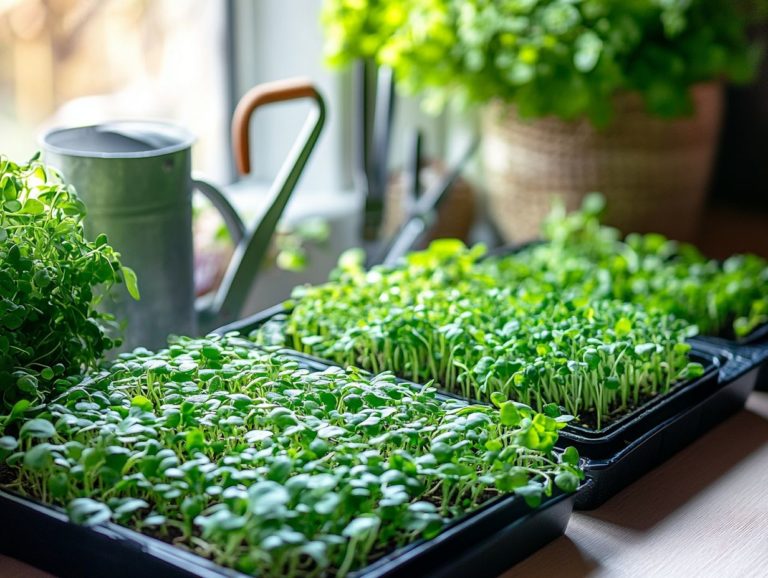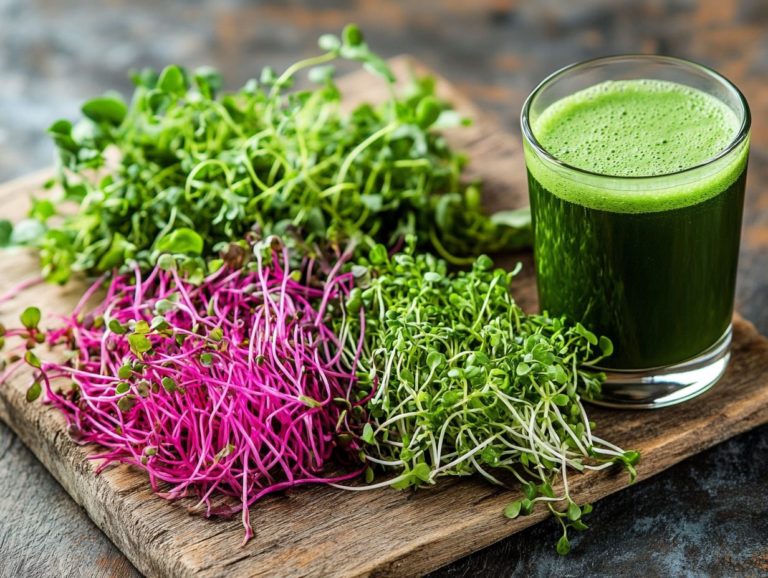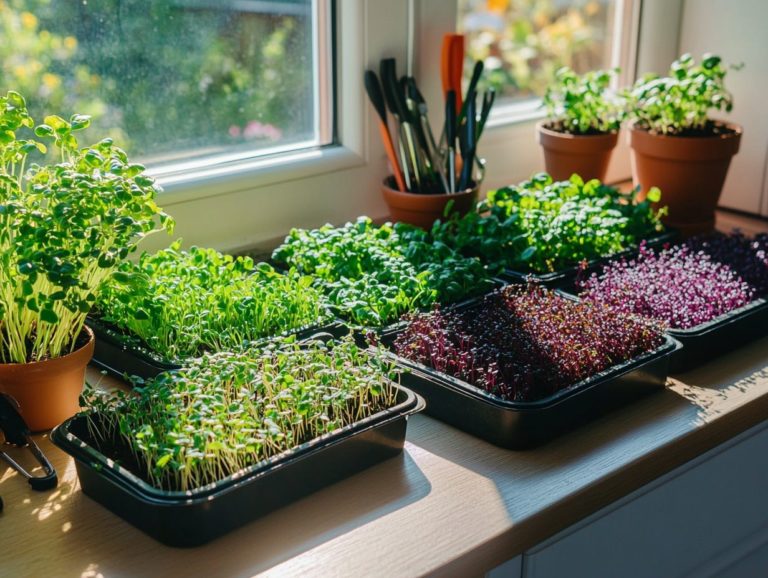How to Maximize Yield in Microgreen Farming?
Microgreens have truly taken the culinary scene by storm. They are celebrated not just for their vibrant flavors and colors but also for their impressive nutritional benefits. As you embrace the journey of healthy eating, you ll notice the soaring demand for these tiny greens. This makes microgreen farming an enticing opportunity.
This guide delves into the fundamentals of microgreens. It examines key factors that influence their yield and shares best practices to ensure optimal growth. You ll also tackle challenges head-on, gaining valuable insights to help you navigate the rewarding journey of microgreen farming with ease.
Whether you re a seasoned grower or just dipping your toes into this vibrant world, this guide will arm you with essential knowledge needed to flourish in this exciting agricultural niche.
Contents
- Key Takeaways:
- Benefits of Microgreen Farming
- Factors Affecting Yield in Microgreen Farming
- Maximizing Yield in Microgreen Farming
- Common Challenges in Microgreen Farming
- Pests and Diseases
- Managing Resources and Costs
- Frequently Asked Questions
- What conditions do microgreens thrive in?
- How can I ensure a high yield in microgreen farming?
- What are some common mistakes that can lead to lower yields in microgreen farming?
- What are some effective ways to increase yield in microgreen farming?
- How often should I harvest my microgreens for maximum yield?
- Are there any alternative methods to increase yield in microgreen farming?
Key Takeaways:
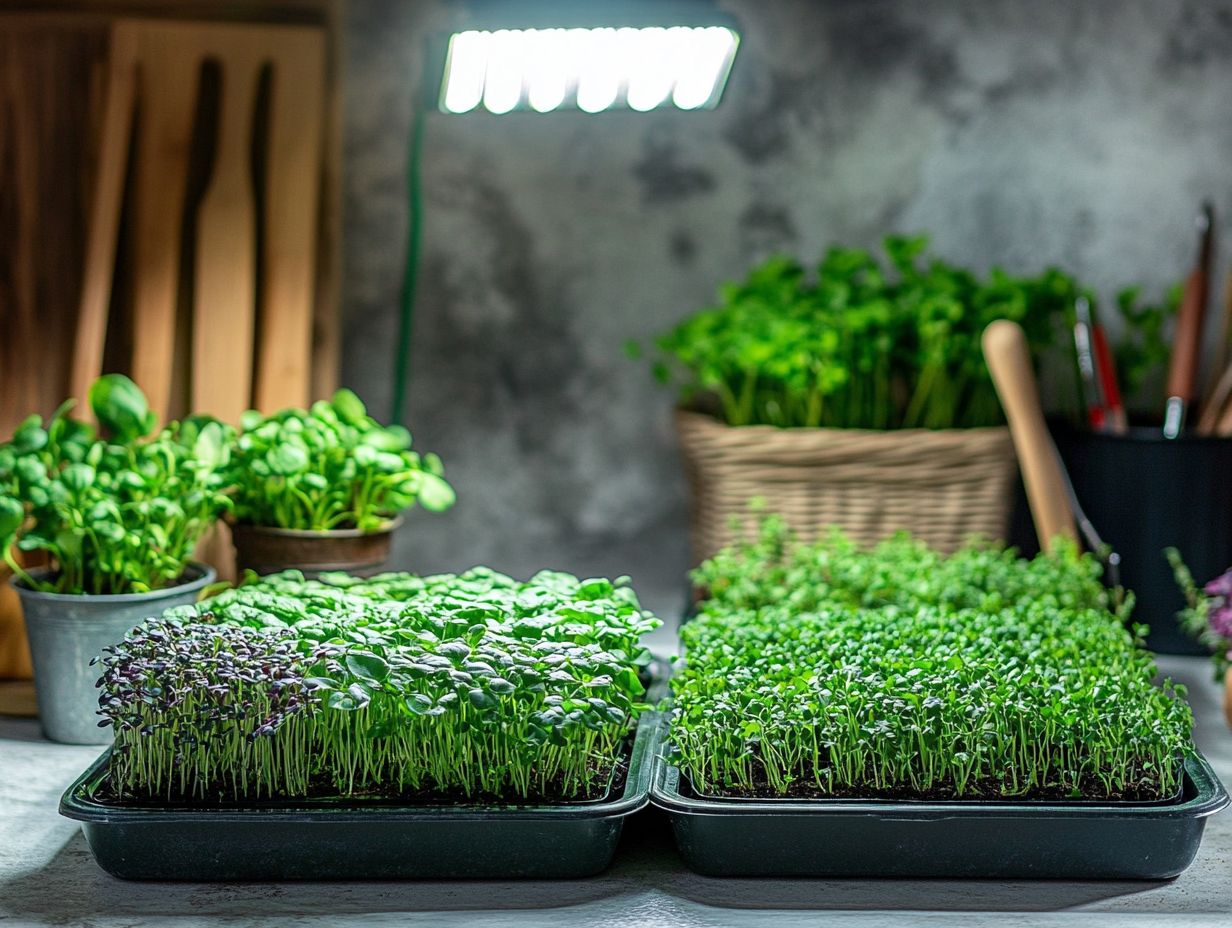
- Choose high-quality seeds for better yields in microgreen farming.
- Harvest at the right time and handle post-harvest properly to extend the shelf life of microgreens and maximize profits.
- Be aware of common challenges such as pests and diseases. Implement effective strategies to overcome them for a successful microgreen farm.
What are Microgreens?
Microgreens are young, edible plants harvested just after the first true leaves emerge, and they pack a nutritional punch that far exceeds their mature counterparts. Varieties like Amaranth, Kale, and Cilantro are not only bursting with vitamins and minerals but are also renowned for their intense flavors and vibrant colors.
These petite greens have become essential in controlled environment agriculture systems methods of growing plants indoors where conditions are controlled for optimal growth. Here, optimal seed density and nutrient management are key to maximizing crop quality. For those interested in expanding their knowledge, exploring techniques for growing microgreens year-round can provide valuable insights.
Cultivated through methods ranging from soil-based systems to hydroponics, these delicate plants thrive in just a few weeks, making them a favorite among home gardeners and commercial farmers alike. Their rapid growth and minimal space requirements play a crucial role in sustainable agriculture, significantly reducing the carbon footprint associated with food production.
Many growers are turning to organic farming techniques, enhancing the allure of microgreens for their culinary benefits and their substantial contributions to food security and nutrition.
With a wide array of options available, including Radish and Broccoli microgreens, the versatility of these young plants invites you to explore different flavors and textures in your meals.
Benefits of Microgreen Farming
The benefits of microgreen farming go far beyond their impressive nutritional profile. These crops are becoming popular not just for their health advantages but also for their cooking flexibility, making them an attractive option for urban greening initiatives.
Microgreens such as Kale and Radish can be found in both restaurant menus and home kitchens, enhancing dishes with their vibrant flavors and visual appeal. Consider farms like FreshSprout Farms, which employ controlled environment agriculture systems to guarantee optimal growth, paving the way for a sustainable food source that meets the demands of modern consumers.
Don t miss out on the chance to grow your own microgreens! Dive into the world of microgreens today and discover how easy it is to grow your own!
Nutritional Value and Market Demand
Microgreens are celebrated for their exceptionally high nutritional value, often packing more vitamins, minerals, and antioxidants than their mature counterparts. This makes them a prized addition in the health-conscious market.
With the rising trend of urban greens, there’s an increasing demand for these nutrient-dense crops. They are easy to grow in limited spaces and versatile enough for various culinary applications.
Among the standout options are broccoli microgreens, famous for their high sulforaphane levels known for their cancer-fighting properties, and radish microgreens, which are rich in Vitamin C and essential minerals that bolster immune health.
Recent studies reveal that the microgreens market is projected to grow at an impressive rate of over 20% annually. This showcases not just consumer interest but also the potential for innovation in sustainable agriculture.
As restaurants and health food brands increasingly incorporate the unique flavors and textures of microgreens, the industry landscape evolves into something vibrant and exciting. This presents opportunities for growers and entrepreneurs to thrive in this flourishing demand.
Factors Affecting Yield in Microgreen Farming
Numerous factors play a pivotal role in determining yield in microgreen farming. Key elements include optimal seed density, effective nutrient management practices, and methods to control pests naturally.
By embracing advanced techniques like growing plants in water and growing plants in air with mist, you can dramatically boost your yields while conserving valuable resources. Grasping these critical elements is essential for maximizing crop quality and ensuring sustainable production cycles.
Growing Techniques and Environment
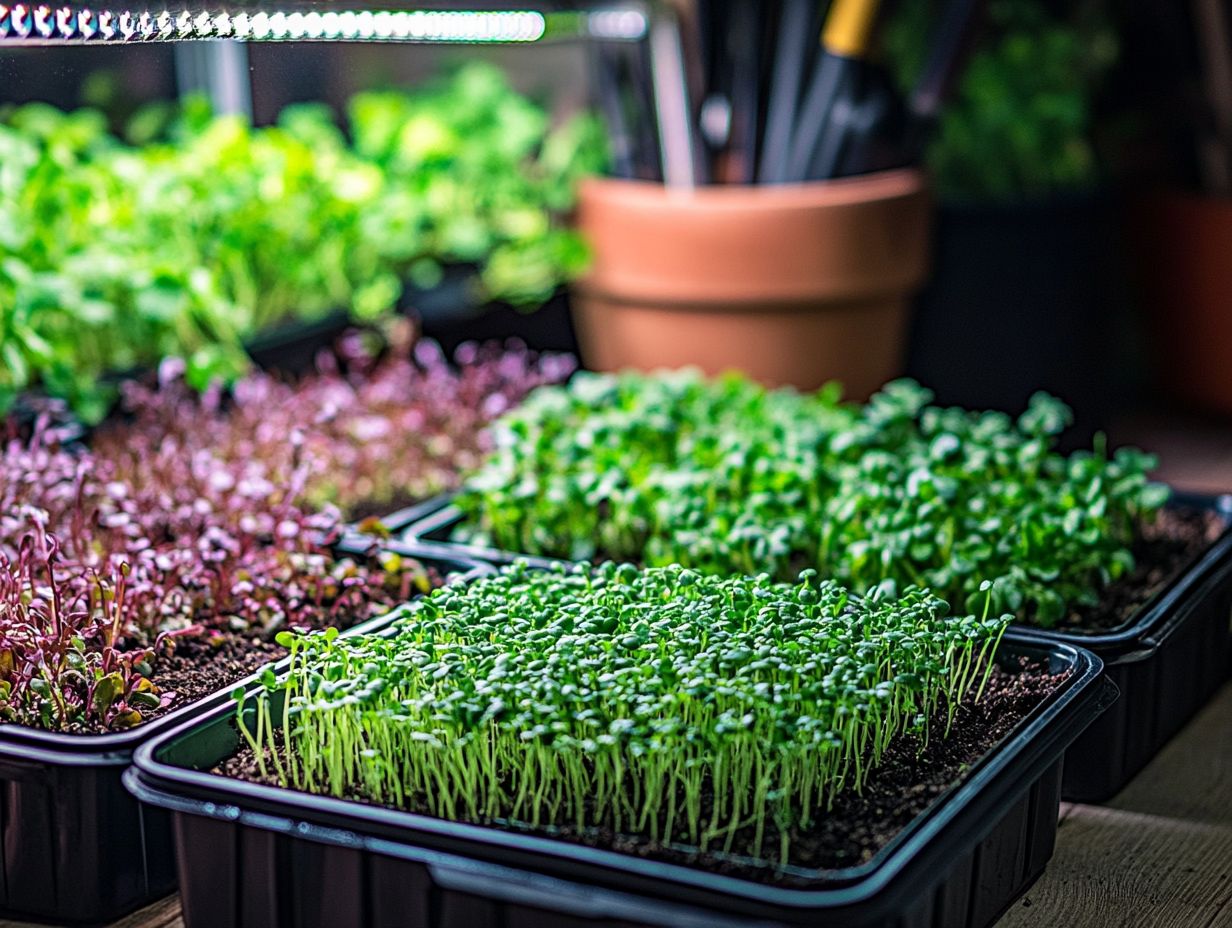
Growing microgreens in a controlled environment agriculture (CEA) system allows you to manage key factors like temperature, humidity, and light with precision. This optimizes growth conditions for various species.
Techniques such as growing plants in water and growing plants in air with mist, used by farms like BrightFarms and Gotham Greens, empower you to cultivate high-quality microgreens year-round, regardless of outside weather conditions.
These advanced methods provide a consistent supply and enhance the nutritional content and flavor profiles of your microgreens. With hydroponics, you grow plants in nutrient-rich water, fostering robust root systems and efficient nutrient uptake. On the other hand, aeroponics suspends your plants in mid-air, delivering nutrients directly to the roots in mist form. This results in faster growth rates and impressive water efficiency.
The technology involved in these CEA systems, such as automated climate control and real-time monitoring, is crucial for maximizing both yield and quality. Comparing these systems reveals that while hydroponics may demand more infrastructure and water management, aeroponics significantly reduces water usage, making it an attractive choice for sustainable agriculture.
Seed Quality and Selection
The quality of seeds you choose for microgreen farming directly impacts your crop yield and overall quality. Thus, seed selection is a crucial part of your production cycle.
By utilizing seed density guides, you can optimize your planting strategies. This ensures that you select the right varieties, like Broccoli and Chard, for maximum flavor and nutrient density.
Sourcing seeds from reputable suppliers guarantees viability and ensures a genetic pedigree that promotes robust growth. Well-chosen seeds form the foundation of a successful microgreen venture, influencing everything from germination rates to disease resistance.
Recommended varieties often include:
- Pea Shoots
- Radish
These options stand out due to their quick maturation and vibrant flavors. By adhering to best practices in seed storage and handling, you can significantly enhance germination potential, ensuring that each planting positively contributes to your overall harvest.
Engaging with local agricultural extensions or seed co-ops can also provide invaluable insights into selecting the most suitable species for your specific climate.
Don t miss out on the booming microgreens market!
Maximizing Yield in Microgreen Farming
Maximizing yield in microgreen farming requires you to adopt best practices across every stage of the cultivation process, from planting through harvesting to post-harvest handling.
Consider techniques employed by farms such as FreshSprout Farms, which include meticulous nutrient management and optimal seed density. By implementing these strategies, your crops can truly thrive while preserving high quality and nutritional value.
Best Practices for Optimal Growth
Implementing best practices for optimal growth in microgreens requires keen attention to nutrient management and ways to manage temperature and humidity.
These elements create the perfect environment for growth. By utilizing high-quality growth media and diligently monitoring environmental conditions, you can achieve robust plant health and superior crop quality.
Besides these foundational elements, prioritize organic fertilizers that enhance the availability of essential nutrients necessary for plant growth. This ensures that each seedling receives the essential elements it needs for vigorous development.
Integrating automated systems to regulate temperature and humidity can significantly enhance the consistency of your growth rates while minimizing the risk of diseases often triggered by environmental fluctuations.
Regularly conducting soil tests to monitor pH levels and nutrient concentrations gives you the power to make informed adjustments, promoting optimal conditions tailored to specific microgreen varieties.
By emphasizing these practices, you not only foster a thriving crop but also contribute to sustainable growing methods that benefit both the environment and your success as a grower.
Harvesting and Post-Harvest Handling
Harvest your microgreens promptly to lock in their peak flavor and nutritional value. Waiting too long can diminish quality. Effective post-harvest handling is equally important, ensuring that the quality of your crop remains intact until it reaches the hands of eager consumers.
Techniques like proper washing, drying, and packaging play a crucial role in maintaining freshness and extending shelf life.
To achieve peak taste, keep a close eye on the growth stages, typically harvesting when the first true leaves—those lovely cotyledons—have fully developed. For optimal growth, consider the perfect light conditions for microgreens. Using sharp scissors or knives helps reduce damage to the microgreens, keeping their taste and appearance intact.
Once you’ve made the cut, washing the microgreens immediately in clean, cool water is vital to remove any contaminants. Following this, drying is crucial to prevent spoilage. In terms of packaging, using breathable containers will enable air circulation while protecting against moisture buildup.
By putting strong quality control in place during harvesting and post-harvest, you guarantee excellent produce that delights your customers.
Common Challenges in Microgreen Farming
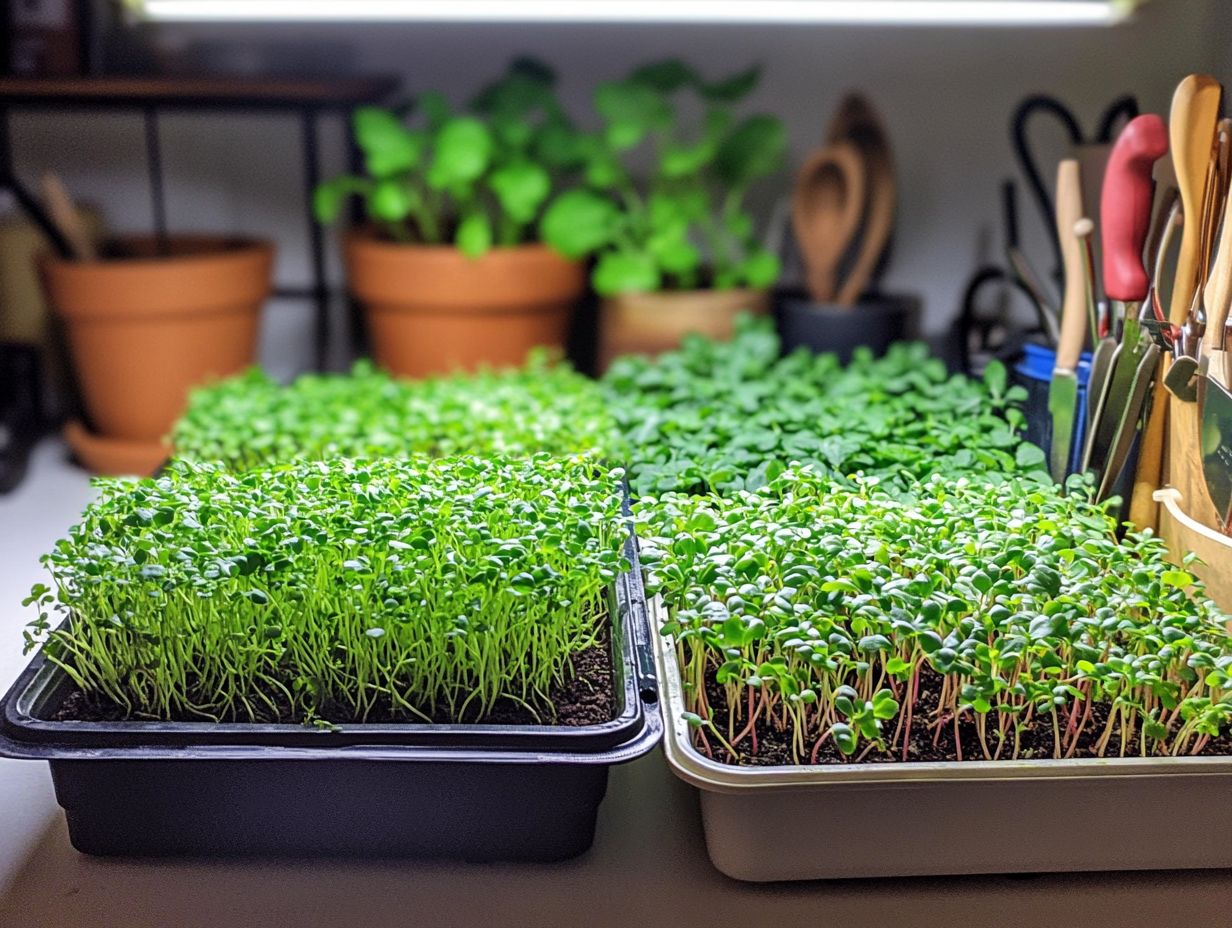
In microgreen farming, you may encounter common challenges such as pests and diseases that can significantly affect both crop yield and quality. Additionally, effective resource management and cost control are essential.
By implementing biological controls and integrated pest management strategies, you can address these issues, ensuring that your productivity remains high without sacrificing sustainability.
Pests and Diseases
Pests and diseases are significant threats to your microgreens, often leading to reduced yields and compromised crop quality. It is essential to implement effective pest management strategies.
By utilizing biological controls, you can effectively mitigate pest infestations, ensuring that crops like Radish and Broccoli thrive in a carefully managed environment.
Common nuisances such as aphids and spider mites, along with diseases like downy mildew, can swiftly decimate your vulnerable microgreen crops. Early identification is key; for instance, you can spot aphids by their characteristic clustering and the yellowing of leaves. Downy mildew often reveals itself as fuzzy spots on the undersides of leaves.
Employing pest management strategies featuring diligent monitoring, cultural practices, and the introduction of predatory insects like ladybugs can significantly enhance your ability to manage these threats. Stay alert and implement these strategies to ensure a thriving microgreen farm!
Managing Resources and Costs
Effective management of resources and costs is essential in microgreen farming, as it directly impacts your profitability and crop quality. You can achieve this by optimizing your nutrient management processes and embracing sustainable practices that minimize waste without sacrificing yield.
One smart approach is to implement a detailed budgeting process, enabling you to track your expenses and pinpoint areas where you can save. Incorporating technologies like automated irrigation systems and nutrient delivery tools can further elevate your efficiency.
For instance, a case study from a successful microgreen farm revealed that by leveraging precision agriculture technology, they slashed water consumption by 30%, significantly cutting costs while ensuring crop health remained intact.
Practicing crop rotation and companion planting enhances soil fertility, promoting better nutrient management that encourages robust, healthy growth.
Frequently Asked Questions
What conditions do microgreens thrive in?
The ideal growing environment for microgreens includes plenty of natural light, a consistent temperature between 60-70 F, and good air circulation.
How can I ensure a high yield in microgreen farming?
Using high-quality seeds is crucial for success! Providing adequate water and nutrients, along with maintaining proper lighting and temperature conditions, will help you achieve high yields.
What are some common mistakes that can lead to lower yields in microgreen farming?
Common mistakes that can lead to lower yields include overcrowding plants, improper watering, using poor quality seeds, and insufficient light or nutrients.
What are some effective ways to increase yield in microgreen farming?
A few effective ways to increase yield include using a proper growing medium, rotating crops, and employing techniques such as companion planting to improve plant health and yield.
How often should I harvest my microgreens for maximum yield?
Microgreens should be harvested when they have reached their full growth and are at their most nutritious state, typically between 7-14 days after planting. Regular harvesting can also help promote continuous growth and increase yield.
Are there any alternative methods to increase yield in microgreen farming?
Yes, various alternative methods can increase yield, such as using hydroponics, vertical farming techniques, and implementing sustainable practices like composting and using organic fertilizers.
